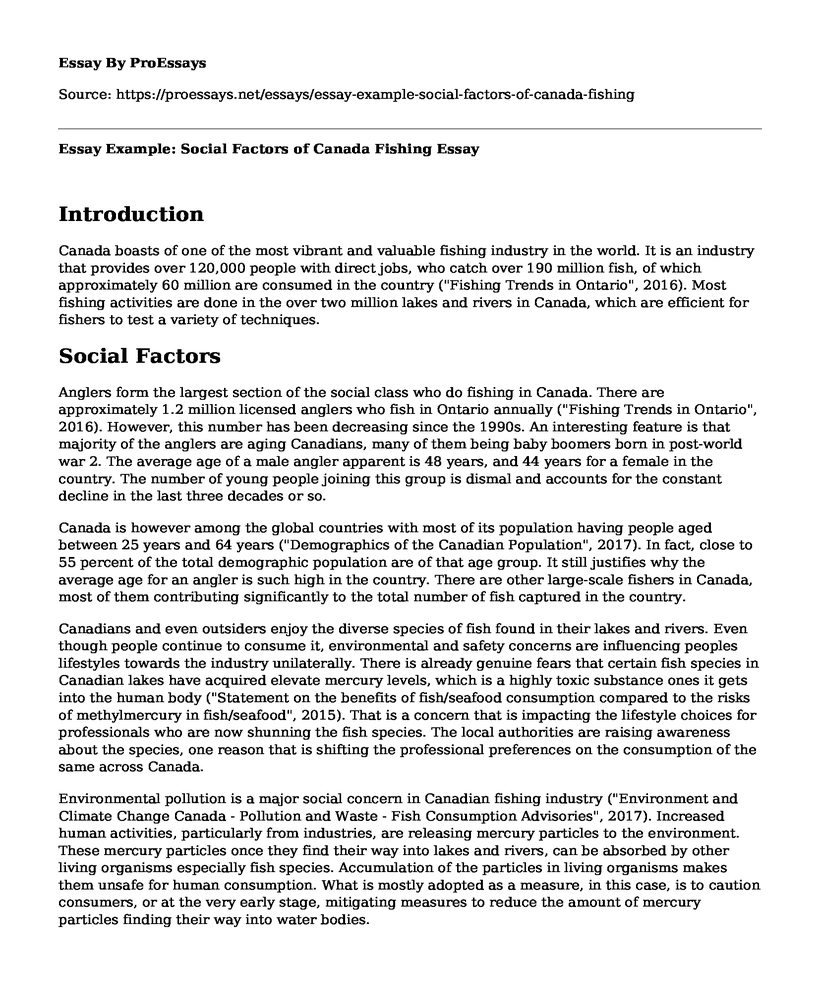Introduction
Canada boasts of one of the most vibrant and valuable fishing industry in the world. It is an industry that provides over 120,000 people with direct jobs, who catch over 190 million fish, of which approximately 60 million are consumed in the country ("Fishing Trends in Ontario", 2016). Most fishing activities are done in the over two million lakes and rivers in Canada, which are efficient for fishers to test a variety of techniques.
Social Factors
Anglers form the largest section of the social class who do fishing in Canada. There are approximately 1.2 million licensed anglers who fish in Ontario annually ("Fishing Trends in Ontario", 2016). However, this number has been decreasing since the 1990s. An interesting feature is that majority of the anglers are aging Canadians, many of them being baby boomers born in post-world war 2. The average age of a male angler apparent is 48 years, and 44 years for a female in the country. The number of young people joining this group is dismal and accounts for the constant decline in the last three decades or so.
Canada is however among the global countries with most of its population having people aged between 25 years and 64 years ("Demographics of the Canadian Population", 2017). In fact, close to 55 percent of the total demographic population are of that age group. It still justifies why the average age for an angler is such high in the country. There are other large-scale fishers in Canada, most of them contributing significantly to the total number of fish captured in the country.
Canadians and even outsiders enjoy the diverse species of fish found in their lakes and rivers. Even though people continue to consume it, environmental and safety concerns are influencing peoples lifestyles towards the industry unilaterally. There is already genuine fears that certain fish species in Canadian lakes have acquired elevate mercury levels, which is a highly toxic substance ones it gets into the human body ("Statement on the benefits of fish/seafood consumption compared to the risks of methylmercury in fish/seafood", 2015). That is a concern that is impacting the lifestyle choices for professionals who are now shunning the fish species. The local authorities are raising awareness about the species, one reason that is shifting the professional preferences on the consumption of the same across Canada.
Environmental pollution is a major social concern in Canadian fishing industry ("Environment and Climate Change Canada - Pollution and Waste - Fish Consumption Advisories", 2017). Increased human activities, particularly from industries, are releasing mercury particles to the environment. These mercury particles once they find their way into lakes and rivers, can be absorbed by other living organisms especially fish species. Accumulation of the particles in living organisms makes them unsafe for human consumption. What is mostly adopted as a measure, in this case, is to caution consumers, or at the very early stage, mitigating measures to reduce the amount of mercury particles finding their way into water bodies.
Conclusion
The fish industry is one vibrant in Canada, and the authorities support the practice as both a commercial and recreational activity. A good number of the anglers are retirees or people on vacation who go on fishing in Canadas lakes and rivers. That, however, do not undermine their role, and the overall impact of the activities. They also form a significant section of the population that consumes fish. The government thus have to initiate broad measures not just to ensure the practice is safe, but consumers are also protected. Consumer protection is, even more, more comprehensive, because it touches t other core areas like lifestyle changes and environmental conservation.
References
Demographics of the Canadian Population. (2017). Ccsd.ca. Retrieved 12 June 2017, from http://www.ccsd.ca/factsheets/demographics/index.htm
Environment and Climate Change Canada - Pollution and Waste - Fish Consumption Advisories. (2017). Ec.gc.ca. Retrieved 12 June 2017, from https://www.ec.gc.ca/mercure-mercury/default.asp?lang=En&n=DCBE5083-1
Fishing Trends in Ontario. (2016). Wildewood On Lake Savant. Retrieved June 2017, from http://wildewoodonlakesavant.com/2016-fishing-trends-in-ontario-canada/
Statement on the benefits of fish/seafood consumption compared to the risks of methylmercury in fish/seafood. (2015). EFSA Journal, 13(1), 3982. http://dx.doi.org/10.2903/j.efsa.2015.3982
Cite this page
Essay Example: Social Factors of Canada Fishing. (2021, Jun 28). Retrieved from https://proessays.net/essays/essay-example-social-factors-of-canada-fishing
If you are the original author of this essay and no longer wish to have it published on the ProEssays website, please click below to request its removal:
- Research Proposal Sample: Relationship Between Migration and Unemployment Among Migrant in Sweden
- Why Is Racial Inequality Still an Problem in America?
- Essay Example on the Role of Government: Protecting & Sustaining Citizens
- The Influence of Western Fashion on People Across the Globe
- Essay Sample on Communication: Sending Messages from One Person to Another
- Essay Sample on Globalization of Business: Intensifying Competition for Enterprises
- Moral Issues of War Police and Terrorism in America - Free Paper Example







